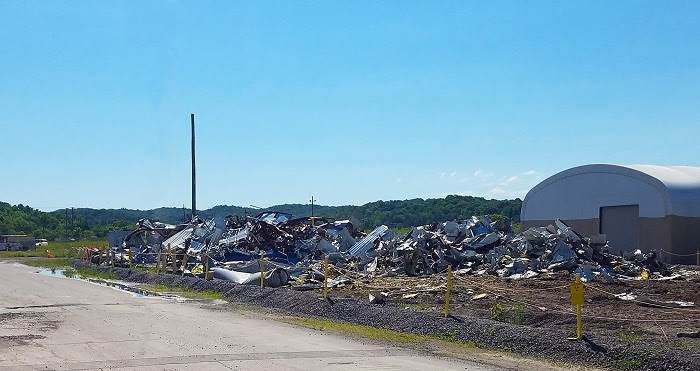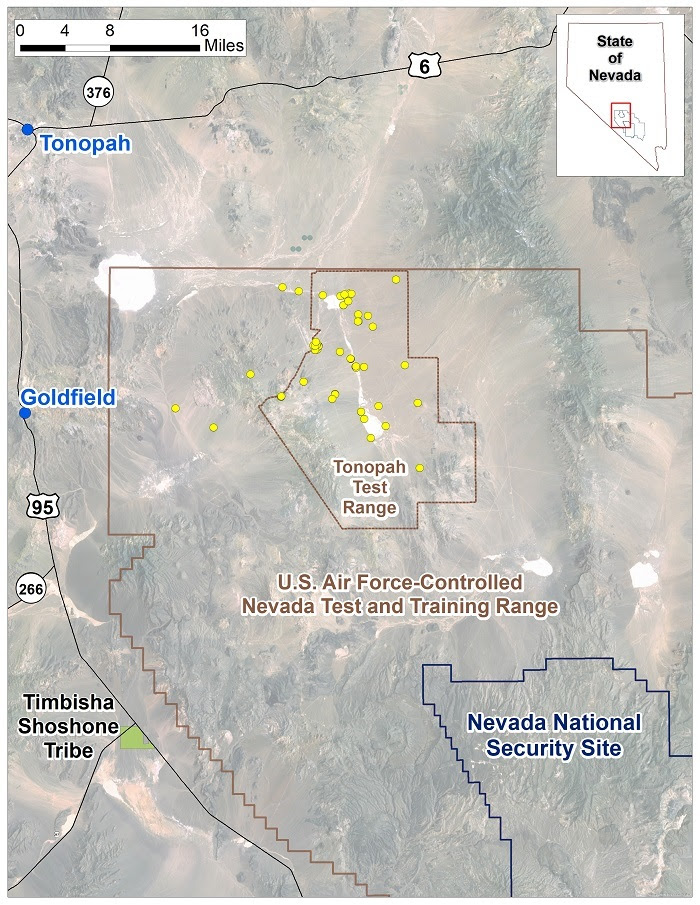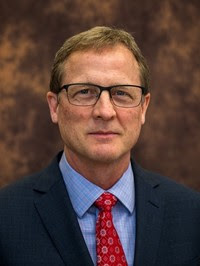
The
DOE Office of Legacy Management is set to assume long-term stewardship
responsibility for 70 sites — represented by the yellow dots in this map
— on the Nevada Test and Training Range where the EM Nevada Program
completed environmental corrective actions in accordance with the
Federal Facility Agreement and Consent Order.
LAS VEGAS – The EM Nevada Program and DOE Office of Legacy Management
(LM) are nearing completion of a transfer of long-term stewardship
responsibilities for 70 sites on the Nevada Test and Training Range
(NTTR), including the Tonopah Test Range (TTR).
The transfer from EM to LM — among EM's ambitious priorities for 2020 — is expected to occur by Sept. 30.
"In
partnership with the Office of Legacy Management and our lead
environmental program services contractor, Navarro Research and
Engineering, the EM Nevada Program is proud to be advancing the transfer
of these sites,” EM Nevada Program Manager Rob Boehlecke said. “We
fully expect to complete the transfer on time and on budget. This
progress supports our federal cleanup mission and shows firsthand what
can be accomplished when a dedicated team works together to accomplish a
goal.”
The transfer process also involves the review and transmission of more than 7,200 documents and records
from the EM Nevada Program to LM. Once the transfer is complete, LM
will assume responsibility for long-term surveillance and maintenance of
the sites in perpetuity.
In accordance with the Federal Facility Agreement and Consent Order (FFACO),
the EM Nevada Program recently completed cleanup at sites on NTTR where
contaminated soil and debris resulted from historic nuclear weapons
testing and support activities. FFACO is a legally-binding agreement
signed in 1996 that outlines a schedule of cleanup and monitoring
commitments.
In
the 1960s, sites at the NTTR were used to test nuclear weapons to
determine if they could be accidentally set off and produce a nuclear
yield. These experiments resulted in the contamination of soil and
debris. During recently completed cleanup of these sites, contaminated soil and debris were transported to the Nevada National Security Site for permanent disposal.
For more information on the EM Nevada Program’s environmental restoration activities, click here.
-Contributor: Michelle French
Oak Ridge Marks Another Teardown on Path to Vision 2020

Demolition
begins on Building K-2500-H. The facility was located near the massive
K-25 gaseous diffusion building and supported demolition efforts for
that project.
OAK RIDGE, Tenn. – The Oak Ridge Office of Environmental Management (OREM) has conducted large-scale demolition at the East Tennessee Technology Park (ETTP) for nearly 15 years.
OREM
and its contractor UCOR are nearing completion of teardowns there, and
one facility they recently demolished had supported demolition work over
the years.
Crews
took down K-2500-H, also known as the Segmentation Shop. Contaminated
equipment, piping, and other items generated by demolition projects were
sent to the facility to be prepared for shipment for disposal.
Constructed in 2007 near the massive K-25 gaseous diffusion building,
the Segmentation Shop was used to process items from K-25, the K-27
gaseous diffusion building, and other facilities that once supported the
site’s uranium enrichment operations.
“The
Segmentation Shop served a crucial purpose, allowing for efficient
disposal of a variety of components pulled from various buildings,” said
James Daffron, acting ETTP portfolio federal project director. “The
fact that it is no longer needed highlights how close we are to
completing site cleanup.”

A
view of the remains from the demolition of the Segmentation Shop as Oak
Ridge crews come closer to achieving Vision 2020. Cleanup efforts at
the East Tennessee Technology Park will remove more than 13 million
square feet of facilities.
While
crews have completed demolition of all facilities that previously
supported uranium enrichment operations, the Segmentation Shop became
the latest in a long list of unneeded buildings that crews have removed
at ETTP.
Only
a handful of unneeded structures remain at the site. Demolition and
major cleanup activities are expected to be completed at ETTP this year —
a goal known as Vision 2020.
It will account for the elimination of more than 13 million square
feet, marking the first time in the world an entire uranium enrichment
complex is removed. More than 12 million square feet of the complex has
been removed already.
OREM
and UCOR are working together to transform ETTP into a multi-use
industrial park, national park, and conservation area for the community.
That vision has already started to become a reality. OREM has
transferred almost 1,300 acres at ETTP for economic development, with
another 600 acres slated for transfer in the years ahead. OREM has also
set aside more than 100 acres for historic preservation and placed more
than 3,000 acres in conservation for community recreational use.
-Contributor: Wayne McKinney
EM Names New WIPP, Los Alamos Managers, Deputy Assistant Secretary for Safety, Security
EM has named new managers for the Carlsbad and Los Alamos
field offices, and a new Deputy Assistant Secretary for Safety,
Security, and Quality Assurance, among leadership updates at its sites
and at headquarters.
Reinhard
Knerr has been selected as manager of the Carlsbad Field Office (CBFO),
where he will oversee operations at the Waste Isolation Pilot Plant
(WIPP). He will transition from his current role as DUF6 Federal Project
Director at the Portsmouth/Paducah Project Office where he supervises the depleted uranium hexafluoride (DUF6) conversion facilities at the Portsmouth, Ohio and Paducah, Kentucky sites.
Knerr
has held leadership and strategic planning roles at the Paducah site
since 2004, including managing environmental remediation work,
transitioning the site’s gaseous diffusion plant from the United States
Enrichment Corporation back to the Department of Energy, and initiating
utility and infrastructure optimization projects. He also has served as
the transuranic waste certification team leader at WIPP, and has over
nine years of experience as a nuclear criticality safety engineer
supporting contractor operations at the National Nuclear Security Administration’s Pantex Plant. Knerr holds a Bachelor of Science in nuclear engineering from the Pennsylvania State University.
At
Carlsbad, Knerr will replace Greg Sosson, who has served as acting
manager since December 2019. Sosson will return to EM headquarters to
serve as Deputy Assistant Secretary for Safety, Security, and Quality
Assurance. That position holds broad responsibility for overseeing the
development of strategies, policy, and guidance for safety, security,
and emergency preparedness to support the EM mission.
Sosson
previously held the position of Associate Deputy Assistant Secretary
for Field Operations Oversight at EM headquarters. Prior to joining DOE,
Sosson was in the commercial nuclear industry for 28 years in senior
operations and engineering positions with a focus on safe and efficient
mission accomplishment, including 10 years as a senior reactor operator.
He also spent 10 years as a light and mechanized infantry officer in
the Army Reserve and National Guard. Sosson holds a Bachelor of Science
in mechanical engineering from the Pennsylvania State University and a
Master of Business Administration from Saint Joseph’s University. He is a
licensed professional engineer.
Mike
Mikolanis, who has been serving as Acting Deputy Assistant Secretary
for Safety, Security, and Quality Assurance, will return to his role as
assistant manager for nuclear material stabilization at the DOE-Savannah River Operations Office (DOE-SR).
Kirk
Lachman has been selected as manager of the EM-Los Alamos Field Office,
following a tenure as deputy manager and acting manager of CBFO. Before
joining CBFO, Lachman was the Deputy Chief for Field Operations at EM
headquarters. He has served in a variety of line management and safety
oversight positions from 2010-2017 at the Nevada Field Office. He served
from 2005 until 2010 as the engineering design group supervisor for the
Office of Civilian Radioactive Waste Management in Las Vegas.
Lachman
graduated from the DOE Senior Executive Service Candidate Development
Program as well as the Harvard Senior Executive Fellows Program. He has a
Bachelor of Science in chemical engineering from the University of
Nebraska and a Master of Science in mechanical engineering from Colorado
State University.
Lachman
will replace Thomas Johnson, who has served as acting manager of EM-Los
Alamos since March. Johnson will return to the Savannah River Site,
where he serves as deputy manager of DOE-SR. In that role, Johnson has
broad leadership responsibility for approximately $1 billion in annual
operating and construction activities at SRS in the areas of
environmental stewardship, and nuclear materials processing and
disposition.
Hanford Marks 25 Years of Successfully Treating Wastewater

A
view of the Effluent Treatment Facility’s process floor. Since 1995,
the facility has processed more than 330 million gallons of contaminated
wastewater to remove radioactive and chemical waste.
RICHLAND, Wash. – A significant component of EM’s complex chain of Hanford Site
waste treatment facilities is marking a quarter century of safely
treating contaminated wastewater while stretching the storage capacity
of underground double-shell tanks.
The “Liquid Waste Processing Facilities”
is a term used to collectively describe four primary facilities that
work together to store, treat, and dispose of large volumes of liquid
waste from around the site. The four facilities are the Liquid Effluent
Retention Facility, Effluent Treatment Facility (ETF), Treated Effluent Disposal Facility, and the State-Approved Land Disposal Site.
Since
1995, the four facilities have processed more than 330 million gallons
of contaminated wastewater to remove radioactive and chemical waste,
primarily from the 242-A Evaporator.
That equipment boils liquid tank waste to evaporate water, also called
effluent, to reduce the volume of waste stored in Hanford’s underground
tanks. Waste volume reduction is also critical for single-shell tank
waste retrievals to double-shell tanks.
“Continued
operations and volume management are important to meeting the Hanford
mission need,” said Richard Valle, Tank Farm program manager.

Two
new vessels were installed in the Effluent Treatment Facility in 2019.
The facility is undergoing upgrades as it prepares to support
Direct-Feed Low-Activity Waste operations to begin by the end of 2023.
The
Liquid Effluent Retention Facility is currently designed to store about
23 million gallons of liquid waste until it can be processed at the
ETF. The ETF processes the liquid waste to remove chemical and
radioactive contaminants. Treated hazardous and radioactive effluent
from ETF is then discharged to the State-Approved Land Disposal Site.
The Treated Effluent Disposal Facility collects nonhazardous and
nonradioactive treated wastewaters that are pumped to two infiltration
basins on the site.
“In
2019, the ETF treated 3.4 million gallons of contaminated wastewater,
exceeding its goal for the year by 1.4 million gallons,” said Brandon
McFerran, ETF manager for Washington River Protection Solutions, EM’s
Hanford tank operations contractor.
The
ETF is undergoing upgrades to improve operations and reliability as
crews prepare it to support Direct-Feed Low-Activity Waste operations.
The ETF is part of the planned 24/7 conversion of liquid waste to a safe
solidified glass form in the new Waste Treatment and Immobilization Plant.
-Contributor: Michael Butler
Spent Nuclear Fuel Transfers Support EM’s Commitment to State of Idaho

EM
workers use a crane to lower a canister filled with spent nuclear fuel
into a liner inside the Radioactive Scrap and Waste Facility at the
Idaho National Laboratory Site.
IDAHO FALLS, Idaho – Crews recently completed the first two of nearly 40 shipments of spent nuclear fuel to a temporary storage area at the Idaho National Laboratory (INL) Site
planned for 2020, helping EM move toward meeting its commitment with
the State of Idaho to transfer the material from wet to dry storage by
2023.
Spent
nuclear fuel handlers and other employees with Fluor Idaho, EM’s INL
Site cleanup contractor, retrieved the fuel from an underwater basin at
Chemical Processing Plant (CPP)-666 at the Idaho Nuclear Technology and
Engineering Center (INTEC). They transferred the fuel to a shipping
cask, which was loaded onto a tractor trailer and transported to the
Radioactive Scrap and Waste Facility (RSWF) at the Materials and Fuels
Complex (MFC). The cask was then unloaded from the trailer, placed over
below-ground steel fuel storage liners, and lowered into place.
The
RSWF, measuring almost 450 feet long and 390 feet wide, was originally
built to receive remote-handled transuranic waste. However,
modifications allowed it to serve as a temporary storage area for the
fuel.
“The
first shipments went off perfectly,” said Russ Cottam, Fluor Idaho
spent nuclear fuel manager. “Our crews had practiced the processes using
a mock-up and used a mobile crane and forklift to simulate the
conditions at the RSWF. The placement of fuel at RSWF went according to
plan.”

Equipment operators move a cask filled with spent nuclear fuel to a storage liner at the Radioactive Scrap and Waste Facility.
Workers
are scheduled to make as many as 38 additional shipments of the fuel
from INTEC to RSWF this year, with shipments continuing into 2021.
Beginning
in September last year, equipment operators, engineers, fuel handlers,
fabricators, and others worked as a team to conduct mock-ups of the fuel
transfers at INTEC. Using a cask assembly built by the INTEC
fabrication shop and a cask designed by INTEC engineers, the team
practiced the transfers.
“So
many dedicated people were involved in this effort,” Cottam said.
“Using a mock-up allowed the team to identify challenges, revise
procedures, and perform the steps flawlessly. It was the epitome of a
well thought-out and executed project.”
The
fuel had originated from the Experimental Breeder Reactor-II (EBR-II)
reactor, which operated at the former Argonne National Laboratory-West,
now MFC, from 1964 until 1994. The reactor generated power for the INL
and provided reactor research benefits. Spent nuclear fuel from EBR-II
was transferred to wet storage at CPP-666 from 1986 to 1999.
The
spent nuclear fuel basin at INTEC is now nearly 95 percent empty. Just
two fuel types remain: EBR-II and Advanced Test Reactor (ATR). ATR fuel
continues to be transferred to CPP-603 for dry storage.
-Contributor: Erik Simpson
Shift Technical Engineer Program Growing to Meet SRS Mission Needs

|
EM Update | Vol. 12, Issue 13 | June 16, 2020
|
||
|
|
||
|
||
EM Nevada Transfer of 70 Sites to Legacy Management Nearly Complete | ||
 |
Reinhard Knerr has been selected as manager of the Carlsbad Field Office.
|
|
Greg Sosson will serve as Deputy Assistant Secretary for Safety, Security, and Quality Assurance.
|
 |
|
 |
After
serving as Acting Deputy Assistant Secretary for Safety, Security, and
Quality Assurance, Mike Mikolanis will return to his role as assistant
manager for nuclear material stabilization at the DOE-Savannah River
Operations Office.
|
|
Kirk Lachman has been selected as manager of the EM-Los Alamos Field Office.
|
 |
|
 | ||
After
serving as acting manager of the EM-Los Alamos Field Office, Thomas
Johnson will return to the Savannah River Site, where he serves as
deputy manager of the DOE-Savannah River Operations Office.
|
||
John
Mills conducts plant gauge checks at the Defense Waste Processing
Facility as part of his job as a shift technical engineer for Savannah
River Remediation at the Savannah River Site.
AIKEN, S.C. – A team of technical engineers is among the many groups growing to support the increased pace of liquid waste operations at EM’s Savannah River Site (SRS).
These
engineers with SRS liquid waste contractor Savannah River Remediation
(SRR) play a key role in daily operations at liquid waste facilities. As
the engineering point of contact on each shift, they work at the Defense Waste Processing Facility
(DWPF) and Tank Farm facilities, home to the underground waste tanks,
helping ensure safe operations, making critical decisions in the field,
and resolving emergent plant issues.
There
are currently two shift technical engineers per shift covering the Tank
Farm facilities and DWPF, and SRR plans to increase it to three per
shift to provide staffing for the ramped-up waste processing expected to
support the new Salt Waste Processing Facility (SWPF). SWPF is the EM
facility that will process the remaining salt waste at SRS, which makes
up about 90 percent of the remaining radioactive waste stored in
underground tanks.
“With
SWPF coming online, there will be more waste transfers, procedure
changes, and emergent issues, and so there is a need to evaluate current
shift technical engineer staffing,” SRR President and Project Manager
Phil Breidenbach said. “The additional technical engineers will provide
increased capability for solving emergent issues on shift without
detracting from their primary role, which is to ensure compliance with
the safety basis.”
More
than 14 engineers have been promoted to shift technical engineer roles
over the last four years, and there are currently 25 in the program —
nine of which are training. Because of the high level of facility
knowledge required, the training and qualification process to become a
shift technical engineer is rigorous. It’s a four-part process:
prerequisites, additional classroom training, on-the-job training, and a
demanding oral examination. It usually takes about a year to become
qualified.
“It
is important to the overall liquid waste mission and day-to-day
operations to identify key people who will perform well as a shift
technical engineer and train them early and thoroughly to take on this
vital role,” Breidenbach said.
For SRR shift technical engineer Annah Garrison, the best part of the job is the people.
“Working
on shift you get to know the people well, and it feels like family,”
said Garrison, who has worked in the position in the tank facilities for
just over two years. “We look out for each other, and we work together
to do the right thing. My shift always challenges me and motivates me to
improve. It feels good to work as a team to accomplish something
together.”
-Contributor: Colleen Hart
|
||
Like EM on Facebook at: https://www.facebook.com/
|

No comments:
Post a Comment